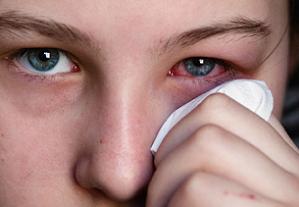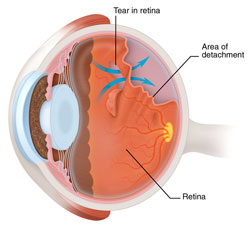Eye Diseases
Your eye health is our top priority. We want to keep your eyes healthy through regular eye health evaluations, communication, and education. This page lists a few of the most common eye conditions and diseases.
Blepharitis

There are two types of blepharitis. Seborrheic blepharitis is often part of an overall skin condition called seborrhea, which may also affect the scalp, chest, back and area behind the ears.
The second form of blepharitis—staph blepharitis—is more common, caused by bacteria, that could begin in childhood and may continue through adulthood.
Causes
Hormones, nutrition, general physical condition, and even stress may contribute to seborrheic blepharitis. Build-ups of naturally occurring bacteria contribute to staph blepharitis.
Symptoms
- Redness of the eyelids.
- Flaking of skin on the lids.
- Crusting at the lid margins, generally worse on waking.
- Cysts at the lid margin (hordeolum).
- Red eye.
- Debris in the tear film, seen under magnification (improved contrast with use of fluorescein drops).
- Gritty sensation of the eye or foreign-body sensation.
- Eye itching
Treatment
Eyelid scrubs with baby shampoo or a specially formulated cleaner can reduce the symptoms of blepharitis. Application of hot packs to the eyes daily can also help. Staph blepharitis may also require antibiotic drops or ointments. The use of artificial tears is often helpful to relieve associated discomfort or dryness.
Recommended Resource
All About Vision:Blepharitis
Back to Top ^Cataracts

A cataract is a cloudiness that occurs in the lens inside of the eye. The lens is made mostly of water and protein arranged to let light through. When the protein clumps, light is blocked and the lens appears cloudy. Cataracts are not a disease; we will all develop cataracts as we get older.
Symptoms
- Clouded, blurred or dim vision
- Increasing difficulty with vision at night
- Sensitivity to light and glare
- Seeing "halos" around lights
- Frequent changes in eyeglass or contact lens prescription
- Fading or yellowing of colors
- Double vision in a single eye
Treatment
Your eye doctor can detect the presence of cataracts during a thorough eye exam, including a microscopic examination of the inside of the eye. When vision is impaired to a point where it interferes with daily activities, surgery may be indicated. Surgery is done on an out-patient basis and involves a very small incision, through which the cloudy substance of the lens is removed and replaced with an intra-ocular lens implant (IOL). With today's technology and surgical techniques most patients find their vision after surgery to be very clear at distance, without the use of glasses.
Recommended Resource
All About Vision:Cataracts
Back to Top ^Conjunctivitis (Pink Eye)

Conjunctivitis is inflammation of the conjunctiva (the outermost layer of the eye and the inner surface of the eyelids). It is most commonly due to an infection(usually viral, but sometimes bacteria]) or an allergic reaction.
Prevention & Treatment
To avoid spreading conjunctivitis, wash your hands often, don't touch the infected area with your hands, don't share wash cloths or towels, and avoid using makeup which may become contaminated. A child with pink eye should be kept from school for a few days. Sometimes your doctor will need to prescribe antibiotic eye drops or ointments to treat conjunctivitis.
Recommended Resource
All About Vision:Conjunctivitis
Back to Top ^ Back to Top ^Dry Eye Syndrome

If your eyes are often itchy or dry, you may have dry eye syndrome, which affects almost 10 million Americans. Dry eye syndrome is caused by a lack of, or poor quality of, tears. Tears lubricate the outer layers of the eye, called the cornea and conjunctiva.
If the tears are not composed of a proper balance of mucous, water, and oil, the eye becomes irritated.
Symptoms
Dry eyes feel uncomfortable. If you have dry eyes, your eyes may sting or burn. You may experience dry eyes in certain situations, such as on an airplane, in an air-conditioned room, while riding a bike, or after looking at a computer screen for a few hours.
Treatment
Treatments for dry eyes may make you more comfortable. These treatments can include lifestyle changes and eyedrops. For more-serious cases of dry eyes, surgery may be an option
Recommended Resource
All About Vision:Dry Eye Syndrome
Back to Top ^Glaucoma

Glaucoma is not just one eye disease, but a group of eye conditions resulting in optic nerve damage, which may cause loss of vision. Abnormally high pressure inside your eye usually causes this damage.
Symptoms
Open angle glaucoma is often called the "Sneak Thief of Sight" because it has no symptoms until the disease is in advanced stages. With advanced glaucoma patients develop tunnel vision, where their peripheral field of vision decreases. Glaucoma can eventually cause blindness.
Risk Factors & Treatment
Heredity seems to be a risk factor. Also, you may be at greater risk if you are over 45, of African descent, very near-sighted, or diabetic. Finally, if you have used steroids or cortisone for a long period of time, or if you have suffered an eye injury in the past, you have a greater chance of developing glaucoma. Treatment may include prescription eye drops, laser treatment, and other surgeries. The goal of treatment is to reduce the pressure, thereby limiting damage to the optic nerve, and preserving vision.
Recommended Resource
All About Vision:Glaucoma
Back to Top ^Macular Degeneration
Macular degeneration is a disease which affects a small area of the retina known as the macula. The macula is the central area of the retina that allows us to see the fine detail of whatever we look at directly. Macular degeneration occurs when the macula is damaged.
"Wet" vs. "Dry"
Most often, macular degeneration is accompanied by the formation of yellow deposits called "drusen" under the macula, which dry out or thin the macula. This is called "dry" macular degeneration. In less common cases, abnormal blood vessels develop under the macula and leak fluid. This is called "wet" macular degeneration.
Causes
A number of uncontrollable factors contribute to macular degeneration, including age, sex, eye color, farsightedness, and race. Risk factors you can control include smoking, high blood pressure, exposure to harmful sunlight, and diet.
Symptoms
It is difficult for patients to detect dry macular degeneration in its early stages. The most common symptom is blurred vision. Wet macular degeneration progresses much faster when it occurs. Symptoms include blurred vision and distortion or a dark spot in central vision. Both forms of macular degeneration can cause severe visual impairment.
Treatment
Treatment for dry, or atrophic macular degeneration includes cessation of smoking, control of high blood pressure and nutritional therapy. The most recent development in the treatment of wet macular degeneration is Photo Dynamic Therapy, which involves injecting a dye, Verteporforin, into the bloodstream and then applying a special, cool laser to the affected retinal area. When successful, this stops the leaking of blood while limiting damage to the sensitive retina above it.
Recommended Resource
All About Vision:Macular Degeneration
Back to Top ^Retinal Detachment

The part of the eye which collects light and transmits the images to the optic nerve and brain is the retina. It lines the inner back wall of the eye. When separated from the back wall, it is known as retinal detachment.
Symptoms
A retinal detachment may cause a sudden defect in your vision. It may just cause a blind spot too small to notice, or it may cause a noticeable shadow which obscures your vision. A sudden increase in "floaters," which look like small particles or fine threads, may also be noticed. Finally, flashes of light may be associated with retinal detachment.
Risk Factors
Most retinal detachments are not caused by any specific injury or event, but eye injuries, tumors, and cataract surgery can cause the retina to detach. Very near-sighted individuals and the elderly are at greater risk for spontaneous detachment. Also, diabetic retinopathy, a condition associated with diabetes, can cause bleeding which can lead to retinal detachment.
Recommended Resource
All About Vision:Retinal Detachment
Back to Top ^